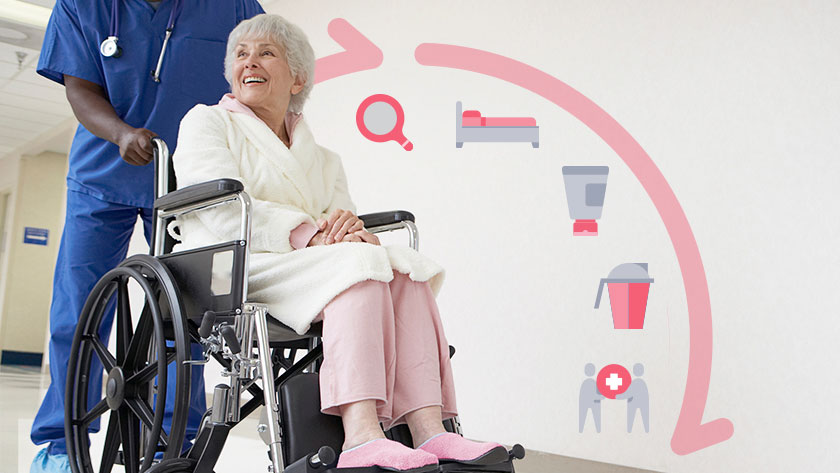How to prevent skin breakdown: Why you need a holistic approach
5 key ways to help maintain skin integrity for at-risk patients.

According to data from the Urban Institute, by 2040, the number of adults ages 65 and older will reach 80 million, more than double the number in 2020.¹ Because older skin is often susceptible to damage, you face a growing challenge—and opportunity—to help prevent skin breakdown for your at-risk patients.
80 million
Number of adults ages 65 and older by 2040.1
In addition to older age, the National Pressure Injury Advisory Panel (NPIAP) lists other risk factors for skin alterations:2
- Acute illness
- Fractured hip
- Spinal cord injuries
- Diabetes mellitus
- Chronic neurological conditions
- Long-term or community care residents
- Trauma and/or prolonged surgery
Some of these risk factors are fixed, such as age and residency in a long-term care facility, but others can be modified to reduce risk. It’s important to take all risk factors into account when the goal is to prevent skin alterations.
For instance, a person with diabetic neuropathy may not feel pain from pressure on their foot and end up developing a diabetic foot ulcer; or a patient recovering from surgery might have difficulty getting to the bathroom and, therefore, be at higher risk of incontinence.

A prevention-first strategy focuses on caring for the whole patient, from their support surfaces to everyday skin care to clinical nutrition. As the NPIAP Guideline says, “The outcome for an at-risk individual can often be altered by carefully selecting and consistently implementing risk-based prevention strategies.”2
Here, we outline 5 important ways to help you achieve your long-term prevention goals and improve patient outcomes
1 |  Start with a proper skin assessment
Start with a proper skin assessment
The NPIAP Guideline recommends conducting a head-to-toe skin assessment “as soon as possible” upon admission to a healthcare facility.2 After that, skin assessments should be ongoing and should be accompanied by documentation, which can help catch skin alterations before they get worse.
2 |  The right support surfaces can have a positive impact
The right support surfaces can have a positive impact
No matter what the care setting, most patients come into contact with mattresses and cushions. Most pressure injuries happen when a person is lying or sitting in the same position for an extended period of time. The length of time it might take for a pressure injury to develop varies, but it can be as little as four hours.3
The right support surface can help prevent pressure injuries by reducing tissue deformation and improving tissue perfusion. They do this through specially designed features including air, gel, water and foam.
What’s the right support surface for your patient population?
38.5%
Of stage 4 pressure injuries occur at the heels2
Important things to remember about support surfaces
- Unprotected heels can lead to skin breakdown. In fact, studies show that as many as 38.5% of stage 4 pressure injuries occur at the heels.2 Offload the heels to help improve outcomes.
- Mattresses need updating to be effective. Medline collected data that showed that 58% of mattresses evaluated needed immediate replacement.

3 |  Best-in-class skin care helps protect and soothe skin
Best-in-class skin care helps protect and soothe skin
Are your skin care products in line with current science? Just as consumer skin care products continually evolve, so do the products you choose for your clinical settings. Some ingredients may be beneficial for fragile skin, while others such as parabens and sulfates might cause irritation.4,5 As we age, the natural barrier of our skin gets weaker, which can make it more prone to pressure injuries and skin tears. When it comes to caring for older patients, it’s important to choose gentle, botanical-rich skin care to cleanse, moisturize, soothe and help protect your patients’ skin.
Patients may also be susceptible to moisture-associated skin damage (MASD), such as incontinence-associated dermatitis and intertriginous dermatitis. Routinely monitor areas of the skin where there’s moisture and warmth, and shield patients against the effects of moisture with the right targeted skin protectants.

4 |  Proper nutrition is important for wound healing
Proper nutrition is important for wound healing
Malnourished patients are 4x more likely to develop a pressure injury.6 When patients aren’t malnourished—either under or over, it could be due to a number of factors, including depression. “Depression breeds malnutrition.”
“From the pressure injury perspective, malnutrition is huge,” Labiak says. “And sometimes you don’t know it until the monthly weight is taken. But by then, the patient or resident could have suffered significant weight loss.”
During isolation due to COVID-19, Labiak says, “I’ve seen people losing 20 or 30 pounds over the year.” Maybe staff had to limit their time in residents’ rooms and weren’t able to monitor what they were eating. “Someone may bring a tray into a room, but if the resident doesn’t know how to cut up their own food, or they’re confused as to what it is or they just don’t feel like eating, someone will come back a half hour later and take the tray out, whether that person has eaten or not,” Labiak explains.

“From the pressure injury perspective, malnutrition is huge.”
—Joanne Labiak, MSN, CRNP, CWOCN, CWS, DAPWCA, owner of Certified Wound Care Specialists, LLC, and a Medline consultant
Another issue Labiak has noticed: “We’ve underestimated the impact of family coming in with treats or just encouraging loved ones to eat a little more.”
While a registered dietitian may be called in for consultation on dietary requirements, be aware of changes in a patient’s attitude toward eating, so you can consider specially formulated supplements to help provide missing nutrition.
5 |  Empower staff to do the right thing
Empower staff to do the right thing
Like the home health care nurse who alerted Labiak to her patient’s hidden risk of skin breakdown, frontline nurses are valuable assets in your goal of prevention. “I think the one thing we want to do is to acknowledge the people who are at the bedside,” Labiak stresses. “A lot of times, they’re the worker bees and no one stops to say what do you think?”
While nurses at the bedside make good decisions all the time, it’s important to give them the tools and resources they need. One great way to do that: Create a Skin Champion team. Not only does this give more staff skin health knowhow, but it also emphasizes prevention for every patient in every unit.
A Skin Champion team also helps you standardize best practices. “If you have guidelines that meet the needs at the bedside, you’re meeting the needs of the patient, and you’re meeting the needs of the organization all at once,” Labiak comments.
Another tool for frontline staff? Checklists that cover NPIAP and your facility’s prevention guidelines. “It’s great to have guidance so everybody is doing what’s best,” Labiak says. “That’s the philosophy of evidence-based best practice.” Download this pressure injury prevention checklist.
When it comes to protecting your patients from skin breakdown, take a holistic view of every individual’s risk factors, and determine if you need to strengthen any of your tools and resources to help improve outcomes.
Key takeaway
As Benjamin Franklin famously said, “An ounce of prevention is worth a pound of cure.” This is true of many things, including preventing skin breakdown. It’s especially true when it comes to your patients and residents who have fragile skin. There are many ways to help keep them safe. It starts with conducting a comprehensive skin assessment, and also includes the right support surfaces and offloading resources, gentle skin care, proper nutrition, and education.
Learn more about preventing skin breakdown:
Discover the role nutrition plays in patient health
Pressure injury prevention: Together, we can reduce the impact
Obesity and skinfolds: 4 proven ways to help shield patients from moisture-associated skin damage
How can you help prevent skin tears in elderly patients?
Pressure injuries: how the right patient skin care products can reduce skin breakdown
References:
- The US Population Is Aging. (2015, April 3). Urban Institute. Available at https://www.urban.org/policy-centers/cross-center-initiatives/program-retirement-policy/projects/data-warehouse/what-future-holds/us-population-aging
- National Pressure Injury Advisory Panel, Prevention and Treatment of Pressure Ulcers/Injuries: Clinical Practice Guideline 2019, page 38, page 67, page 73, pages 145-154
- Gefen, A. (2008). How Much Time Does it Take to Get a Pressure Ulcer? Integrated Evidence from Human, Animal, and In Vitro Studies. Wound Management & Prevention, 54(10), 26–35. Available at https://www.o-wm.com/content/how-much-time-does-it-take-get-a-pressure-ulcer-integrated-evidence-human-animal-and-in-vitr
- Stoiber, PhD, T. (2019, April 19). What Are Parabens, and Why Don’t They Belong in Cosmetics? Environmental Working Group. Available at https://www.ewg.org/what-are-parabens
- Ginta, D. (2019, August 12). Should You Be Going Sulfate-Free? Healthline.Com. Available at https://www.healthline.com/health/beauty-skin-care/sulfates
- www.tnpatientsafety.com/pubfiles/The%20High%20Price%20of%20Undiagnosed%20Malnutrition%20-%20Kathy%20J%20Irwin.pdf
